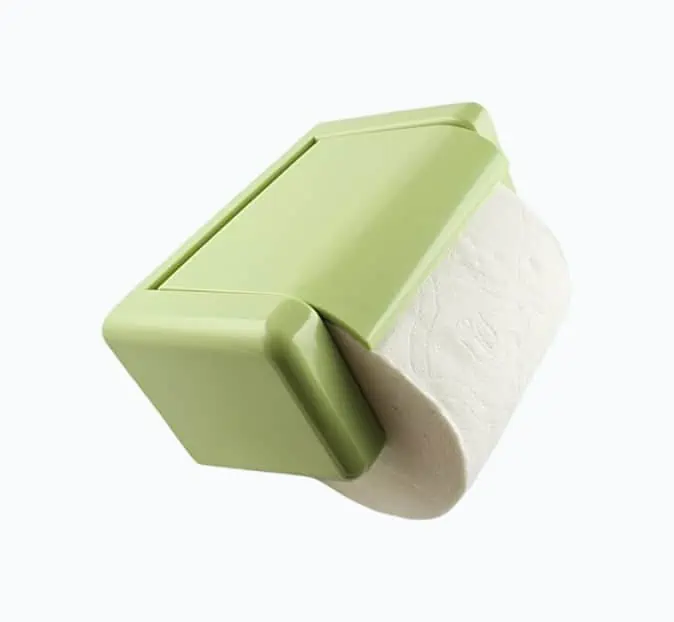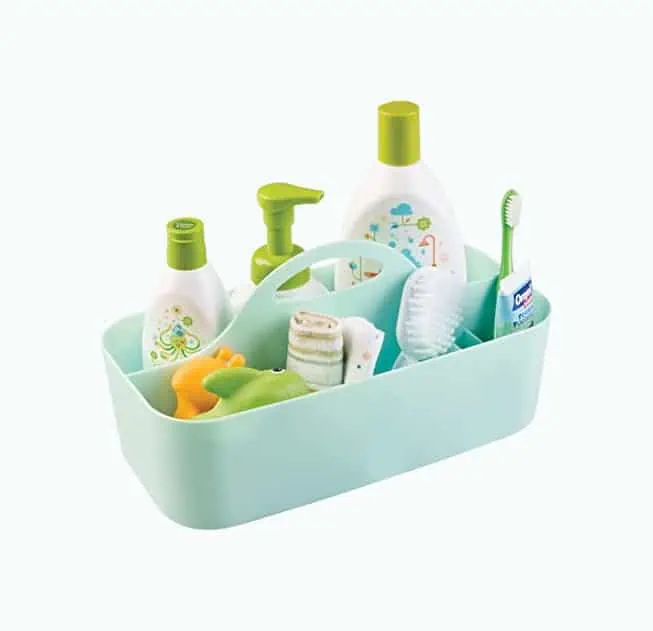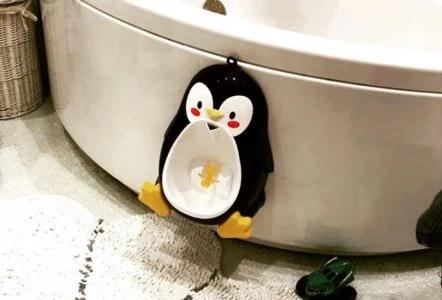Has babyproofing made you see your bathroom in a completely new light? Do you find yourself noticing the slippery surfaces, toxic chemicals, cluttered counters, and all the other potential hazards?
If so, take a deep breath — there are ways to fix this!
Between all of us, we’ve babyproofed many bathrooms and toilets over the years and have learned to cover all the angles. We’ll share the essentials for babyproofing your bathroom so you can find peace of mind and keep your baby safe.
What areas should you focus on? Are there products to make it easier? Read on to make sure your bathroom stays a safe place for your little one.
Key Takeaways
- Babyproof your bathroom before the baby arrives to build good habits and ensure safety.
- Lock bathroom doors, use toilet seat locks, and secure toilet paper holders to prevent accidents.
- Install non-slip mats, spout covers, and use bathing seats in bathtubs for added safety during bath time.
- Keep hazardous items out of reach, lock cabinets, and clear bathroom counters to prevent your child from accessing dangerous items.
When to Babyproof Your Bathroom
Of all the rooms in your house, babyproofing the bathroom may seem easy to put last. After all, your baby won’t be mobile for the first few months of their life, and you can lock bathroom doors.
However, we strongly encourage parents to address the task of babyproofing before their bundle of joy arrives. Why?
There are a few big reasons.
1. You’ll Get Busy
You have so much to do with a new baby! You don’t want to miss a moment worrying about how your cabinets open or what’s inside your drawers. If you start early, you’ll build good habits.
2. You’ll Perfect Your System
You can take more time to babyproof the bathroom and toilet if you start early. The more time you have to perfect your home, the less stress you will experience. The best way to make sure you don’t miss anything when it comes to babyproofing an area of your home is to take your time.
Go inside the bathroom and sit on the floor. See things from your child’s point of view. This exercise will allow you to see potential dangers and hazards you might not be aware of.
3. You’ll Learn as You Go
As you’ll quickly find out, children will get into all sorts of places you’d never expect. If you have a solid base of defense built up, you can add little safety measures to places you didn’t see initially — which is way easier than doing the whole thing at once.
We understand ensuring your baby is safe is a huge necessity, and babyproofing can be daunting. However, it’s not complicated or scary if you handle it on a task-by-task basis.
How to Babyproof Your Toilet
We don’t like to think about our toilets. We use them every day and walk away without a thought. To babyproof your toilet, it’s a good idea to think about the different ways it could be dangerous.
For example, many parents don’t think of the toilet as a drowning hazard. However, children can drown in as little as two inches of water (1). When you consider the bolts at the toilet’s base, heavy lids, and streams of toilet paper, it can be a potential disaster just waiting to happen.
Here’s how to babyproof your toilet in five easy steps to prevent these disasters.
1. Lock the Door
The most convenient way to babyproof your toilet (and entire bathroom) is to install a lock on the door that will allow you to lock it from the outside. The lock should be out of your child’s reach. There are three types of locks typically used for this essential task.
Doorknob Cover
This product is a little different than a lock. But a doorknob cover will keep your baby from entering the bathroom — as long as the door is closed. To open the door, you need to grip the doorknob through the two holes in the sides of the cover to turn. This action is too complicated for most babies and toddlers as their hands are small and they can’t usually figure out that they need to grip the knob instead of the cover.
If a little one tries to open the door, the cover will slip on the knob, preventing it from turning.
Safety Chain Locks
Chain locks are commonplace, meaning you can find them easily and at varying price points. They can be installed quickly and are relatively simple to use.
Simply screw the plate into the door and the chain to the frame. The chain has a knob at the end that slides into the plate and secures at one end.
Barrel Bolt Locks
Barrel bolt locks are a bit sturdier than chain locks and leave little room for small fingers to get caught in the doorway.
A barrel bolt lock comes with a tube-like piece of metal inside a barrel, which is then slid into a chamber. The tube must be lifted and slid out of place to open the door.
Hook and Eye Locks
A hook and eye lock is the easiest to open for anyone who can reach it. Simply place the hook in the eye to lock the door. This is a great option for keeping out younger children, but older children may use enough force to break the lock or figure out a way to reach it.
With a lock on the door, you can easily get into the bathroom and out again. However, there are some disadvantages.
You will have to train guests to lock the door behind them, and younger but responsible children may not be able to reach the locks at all. Locks are also fairly permanent after you install them and are visible.
Quick Tip
2. Toilet Seat Lock
Children love to splash around in water — and an open toilet bowl provides a great opportunity. It also provides ample opportunity for trouble.
Aside from potential drownings, toilet bowl lids can crash down on your little one’s fingers or bonk them on the head. If the toilet bowl is open, many items can get thrown in and flushed down.
The easiest way to keep your toilet seat shut is with a lock. There are several styles and designs available. Look in your local baby or hardware store to explore the best options for your home.
You may even need a different kind of lock for each toilet, depending on how much access your child has to each bathroom. Toilet seat locks are not always the most convenient for adults.
3. Toilet Paper Holder

If your little one likes to tug on the end of the toilet roll and unravel the paper, creating a big mess in the bathroom, this product could help.
It has a lid flap that holds the toilet roll down. This is specifically designed to protect the roll from kids and pets as it’s much harder to tug and unravel the toilet roll now.
It also makes it easy to tear off the right amount of toilet paper with one hand when parents use the bathroom.
TP Safety Tip
4. Toilet Bolt Caps
For obvious reasons, your toilet is bolted into place. There’s a good chance your toilet bolts already have caps to eliminate sharp corners. Double-check to ensure caps are present and they come off easily.
If your toilet’s base does not have caps, a long bolt will be sticking straight up. Depending on the type of toilet bowl cap you purchase, you may need to saw the bolt down. However, many caps are designed to screw on with ease.
5. Toilet Handle Lock

Prevent your child from flushing anything down the toilet by locking the handle.
Simply attach the lock to the toilet underneath the handle. The lock works as a stopper, preventing the handle from being pushed down all the way. Press the red button to release the lock, which will allow you to press the handle down.
How To Babyproof Your Bathtub
Two-thirds of drownings that occur in the home take place in the bathtub. The number one thing you can do to prevent any danger to your child in the bathtub is to supervise them.
Beyond supervision, there are a few simple ideas that, when correctly implemented, can ensure bath time remains safe and fun.
1. Non-Slip Mat
Place a non-slip mat on the bottom of your bathtub. This will ensure your child does not slip when they are inside the tub. It can be very easy for your baby or toddler to tumble over, even if they’re sitting still!
Two types of non-slip bathtub mats are common: a mat that runs the tub’s length or a set of individual tub stickers. These can be especially fun for children as they come in all different shapes and patterns.
Bath Mat Tip
2. Spout Cover

When you place your toddler in the tub, you may notice their height is even with the water spout — primed and ready for a bonk on the head! This presents a potentially painful and dangerous hazard.
Many mothers love cute spout covers to add some fun to bath time while protecting their children. The covers go over the spout and are generally made of soft rubber or silicone.
3. Tub Separator
Are you looking for a way to save water and keep bath time safe? A tub separator allows you to section off a part of your tub — so you can even get into the tub without getting wet.
A tub separator helps keep your baby safe because it limits the amount of room your baby has to navigate inside the tub and helps you control their environment.
4. Bathing Seat

When you have an infant, you typically use special tubs and seats for bathing. You don’t have to ditch this safety method as your baby gets bigger. You can use a full-sized tub while still keeping your baby contained.
Bathing seats for full-sized tubs allow room for your baby to move and splash while sitting up. Inflatable safety tubs, which mimic bathtubs, are also available.
As your child grows, the type of bathing seat appropriate for them will change. Make sure to read all of the information provided with each seat you buy to determine when you will need a change of product.
5. Bath Organizer

The bathtub is the most dangerous when left unsupervised. This is true even if it’s not filled with water or in use. From shampoos and washes to toys, there are many things your little one can get into!
Limit your stress by keeping everything you need in one place with a bath organizer or caddy.
Gather up the shampoo, toys, washcloths, and whatever else you may need, and put them in an organizer. It can be as simple as a plastic tote. You can also purchase mesh organizers for storing bath toys.
Pro Tip
Babyproofing Your Bathroom Cabinets
Children love to explore — and they have an uncanny ability to get into everything. If your bathroom cabinets are not locked, they can explore hair styling tools with long cords, soaps and shampoos, medicines, and even poisonous cleaning materials.
Follow these step-by-step instructions to babyproof your cabinets without stress.
- Remove hazards: Take any poisonous or hazardous materials and move them to a higher cabinet. Even if an item seems harmless, ask yourself if you want your child to access it.
- Audit items: Simply leaving cabinets empty is not a great choice for busy moms and dads who need to make the most of their space. Some are safe to leave within reach. A few items you can keep in your bathroom cabinets are towels, clean sponges, unopened packages of toilet paper, and a scale.
- Purchase locks: The easiest way to ensure your child does not get into your bathroom cabinets is to use cabinet locks. Many different kinds are available, including magnet locks, sliding locks for side-by-side handles, and cord locks.
The goal with babyproofing your bathroom cabinets is to keep dangerous things out of your child’s tiny hands while still having access to everything you need. Experiment with a few different types of locks to find one that works best for you.
Babyproofing Your Bathroom Counter
Do you keep all your toiletries on the counter or organized in drawers? If your items are on the counter, now is the time to make a change!
Leaving stuff on the counter may entice your child to start climbing. Remove the temptation by keeping everything hidden away in locked drawers or cabinets. This is the simplest step to babyproofing your bathroom counter.
However, there are a few other things you should keep in mind.
1. Hairstyling Implements
Never leave hair styling equipment turned on and unattended when a child can get to it. This includes curling irons, blow-dryers, and flat irons. If you turn your back for one moment, they can grab the cord and pull it down.
2. Corner Guards
Add corner guards to your bathroom counters. As your child grows, they will likely start climbing and exploring things. You don’t want them to climb up on the toilet and fall, hitting their head on a sharp corner.
3. Remove Stepping Stones
In the same arena as climbing, remove or lock away any apparatus that could be used as a stepping stone — this includes step stools. If your child can get on top of the toilet, which is already dangerous, they can reach the counter.
Extra Babyproofing Bathroom Tips
Want to go the extra mile? When it comes to babyproofing your bathroom, attention to small details can make all the difference.
- Toilet brush: Does it give you the shivers to think of what’s on the end of your toilet brush? Us too! Keep your toilet brush somewhere your child can’t reach it, like under a locked cabinet in the sink.
- Shower curtains: Mold and mildew can grow on shower curtains, so find a shower curtain made of vinyl or nylon for easy cleaning.
- Shower rods and rings: Invest in a strong shower rod and shower curtain rings. As your baby grows, there’s a good chance they’ll tug and pull on the shower curtain. Ensure the rings and rod can hold your child’s weight to avoid a nasty crash.
- Water temperature: Your child’s skin is sensitive. Hot water can easily irritate or even scald their skin. Get a bath thermometer to ensure your baby’s bathwater is at the perfect temperature. Run cold water first, then add hot water to the desired temperature.
- Garbage: Your bathroom trash can gets some of the most germ-filled pieces of trash in the entire household. If not looked after properly, it can end up all over the floor.
Get a trash can with a lid for extra security, and take it out regularly. If you can, place a small trash can in a locked cabinet.
Teaching About Bathroom Etiquette
One of the most important things you can do is teach your child bathroom etiquette and why they’re not allowed to do certain things.
This is an especially important aspect of potty training. You want your child to be able to use the bathroom properly and make the learning process as stress-free as possible. It’s not always easy to babyproof an area while still providing an environment your child feels comfortable in.
Strive to create at least one bathroom in the house just for your children to have a place to learn and grow while still being safe.
You can do this by using bright colors, child-friendly toys and decor, and products your child can use without supervision as they grow older.
FAQs
Your Bathroom Babyproofing Tips
By following the tips listed in this article, you’ll be well on your way to having a safe yet functional bathroom for your entire family.
Parents with children of all ages understand how overwhelming babyproofing the bathroom and toilet can be. We suggest starting with one section at a time so you don’t have to strain to do everything at once.










